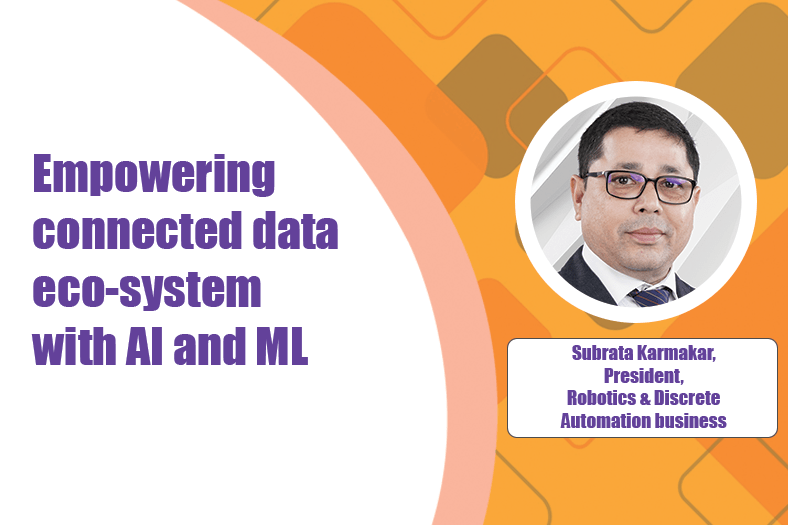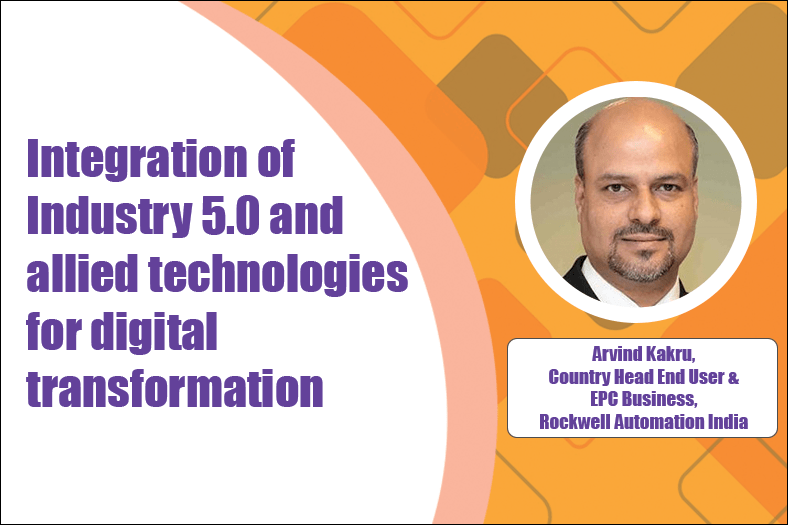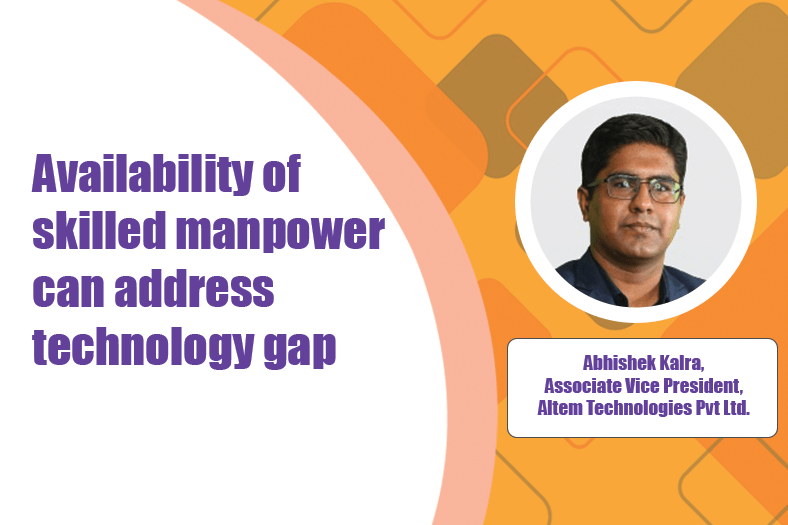Empowering connected data eco-system with AI and ML
June 9, 2021 2:22 pm
The future factory should be able to respond much more dynamically to everchanging consumer requirements.
Subrata Karmakar, President- Robotics & Discrete Automation business, ABB India Ltd., in an interview with OEM Update, talks about ABB’s latest robotic technologies and explains how they can transform the industrial process.
Transitioning towards Industry 5.0
The onset of industry 4.0 in India has managed to set up a well-established ecosystem within the country’s manufacturing capabilities. Today, we are already seeing the effects of increased productivity and efficiency and overall improvement in working conditions brought about by Industry 4.0. The transition or further upgradation to Industry 5.0 is expected to witness a faster adoption rate owing to industry readiness.
Automated and connected factories are the future of manufacturing, and Industry 5.0 is touted to take this further. Industry 5.0 will merge the precision, speed, productivity, and consistency of robots with the creativity and craftsmanship of humans. Today, consumers demand for tailor-made products for their intricate needs, and in a limited time. The factory of the future must therefore be able to respond much more dynamically to ever-changing consumer requirements, changing demand and current trends.
The changes brought about by Industry 5.0 will shift the focus from rigid automation to flexible application. While Industry 4.0 relied heavily on bringing robots to the manufacturing process, Industry 5.0 will be about ‘Cobots’ or collaborative robots, that work in collaboration with humans.
Mechanical automation processes will now be capable of high mix/low volume production in shorter cycles due to the increased flexibility that Industry 5.0 solutions provide with the best use of human and robot capabilities at various levels of the process flow. This will allow manufacturers to test and release innovative products at an unprecedented pace while maintaining safety, quality and productivity standards. Also, reliability to offset rising cost of downtime in shorter cycles.
Furthermore, Industry 5.0 will allow robotic applications to extend from mechanical automation into design and more creativity-based applications.
Bridging manufacturing gap with AI, machine learning and 3D printing
Automated and Artificial Intelligence enabled processes have empowered the creation of a connected data eco-system. With the added capabilities of Machine Learning, these systems can identify complex patterns, accumulate experience, and use them to continuously improve and self-optimise over time. Some of its examples are recognition and identification features, finding optimal picking vectors, or efficiently assembling parts together. Much like a human being who learns by doing, a robot develops its adaptability through collected experiences and becomes increasingly flexible, capable and effective.
With these capabilities, robots can now navigate and operate unfamiliar objects with minimal or no manual/programmatical intervention. For example, autonomous grasping makes use of a combination of vision systems and AI/ML algorithms that help a robot understand the size and shape of the object and find an optimal gripper position and pressure.
Advanced simultaneous localisation and mapping technologies (SLAM) enable mobile robots to navigate in a dynamic three-dimensional space by constructing a digital map and make tracking the position of a robot within the map possible without the aid of GPS. Some examples include Automated Guided Vehicles (AGVs) which can deliver parts in a factory, changing their path to avoid obstacles, such as if a maintenance worker places a cart in the middle of a pre-established path. These robots help companies in their efforts to lower utility and structure damage costs and also help increase workplace safety.
ABB offers a range of solutions that combine robotics and machine learning. These include the use of AI to enable robots to sense and respond to their environment, inspect and analyse defects, and optimise processes autonomously. For instance, robots equipped with vision sensors can use AI to identify objects regardless of their position.
Challenges in adopting digitalised technologies for SMEs and MSMEs
SME and MSMEs are the backbone of the national economy and already ramping up automation in the manufacturing process. And some of the challenges that SME and MSME sector faces in adopting factory automation, digitisation and robotics are the mindset calibration in-terms of cost and complexity. There is an unsubstantiated understanding that this shift to robotics requires significant engineering and programming know-how. This is far from reality.
Robots have become easier to install, program, and operate than ever before. Lead-through programming enables an end-user to program a robot and have it running in minutes, without the need for specialised training. Robots that can be programmed and deployed without special training will lower the barriers to entry for new users and new markets.
ABB’s simulation and offline programming software, RobotStudio®, enables configuration, programming, and virtual commissioning (pre-installation). It offers a comprehensive digital replica – a digital twin – of physical assets or systems, all on your personal computer. By providing visual access to the production line in a virtual 3D environment, it enables the creation, simulation, and testing of a robot without having to disturb the actual production line. This means that new production lines can be installed faster and ramped up to full speed without surprises during commissioning.
The way forward with Industry 5.0
ABB’s purpose-driven and application-based Robots and Cobots serve a multitude of applications at various process-points. They are collaborating with humans in a growing number of industries far beyond manufacturing and in businesses of all sizes – from the biggest production site to the smallest workshop or restaurant.
We are currently witnessing a growing demand for automation, not only in large companies in industries like automotive and electronics, where robotics is already in place but also in small and medium sized companies, as well as new segments, like healthcare, consumer goods, logistics and retail, which currently have a low level of robotic automation.
ABB’s Cobot family ranges of GoFa, SWIFTI and YuMi are equipped with state-of-the-art safety features. These robots can be installed partially or entirely without physical fencing. These smart machines support collaborative work at various degrees ranging from close collaboration to intermittent collaboration and co-existence. Automating a broad range of tasks including machine tending, component assembly and packaging, their applications are not limited to a car manufacturer or a small bakery.
These machines are capable of working along-side humans as co-workers on various tasks across industries. These include machine tending, assembly and testing and packaging in manufacturing, laboratories, logistics hubs, and small production facilities. In larger facilities, they can be mounted on AGVs to replenish material for production lines. In a car plant, they can support workers in the final assembly stage, mounting parts while working closely with human co-workers. In a warehouse, they can work together with humans in customised packaging tasks, such as holiday gift packs. In a production facility, they can help workers with assembly tasks including screwdriving.
Cookie Consent
We use cookies to personalize your experience. By continuing to visit this website you agree to our Terms & Conditions, Privacy Policy and Cookie Policy.









